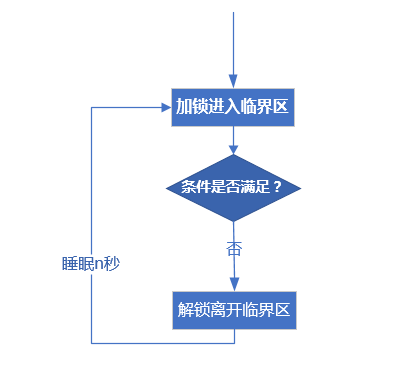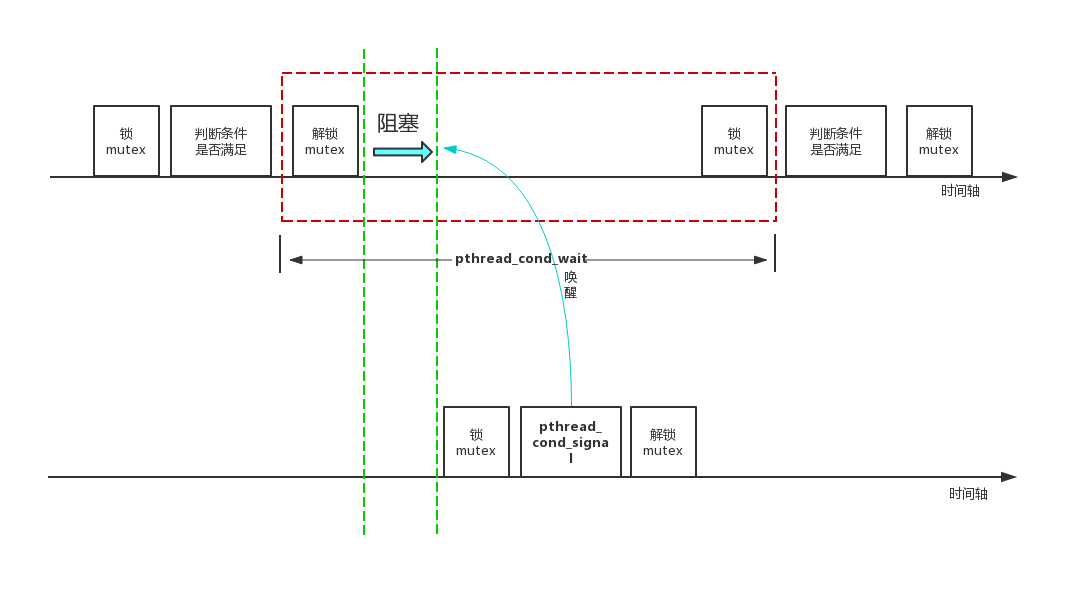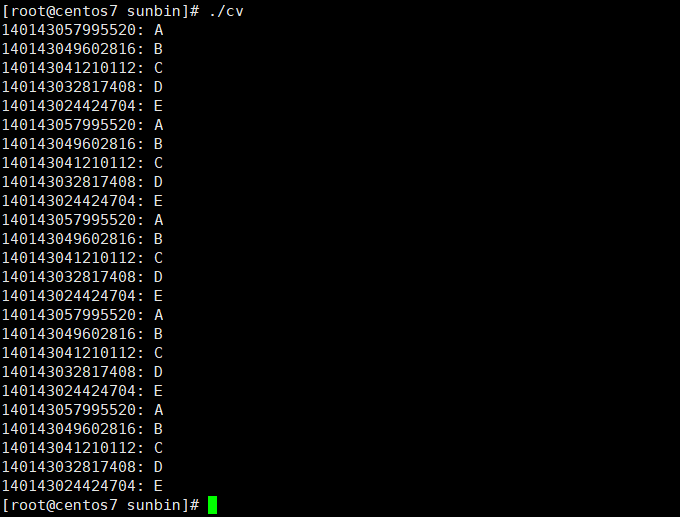【linux编程】条件变量
使用条件变量的原因
如果没有条件变量,那么我们等待一个条件满足则会是下面这样的模型:

首先加锁进入临界区去查看条件是否满足,不满足则解锁离开临界区,睡眠一段时间再继续循环判断。在这种情况下如果刚离开临界区,条件变为满足,那么线程必须还要等一段时间重新进入临界区才能知道条件满足(如果在这段时间内,条件依旧一直保持满足的话),如果这一小段时间条件又变为不满足,那么这个线程还要继续循环判断。不断地加锁解锁(会影响使用同一把锁的其他线程),还不能第一时间收到条件满足。这种模型既费时又开销大。
所以条件变量的产生,正是为了不循环加锁解锁,并且第一时间收到条件满足的通知。
2. 条件变量相关函数
函数原型:
pthread_cond_wait(pthread_cond_t *cond, pthread_mutex_t *mutex);分析:函数作用:阻塞等待一个条件变量
- 阻塞等待条件变量cond(参数1)满足 (第一步)
- 释放已掌握的互斥锁(解锁互斥量),相当于pthread_mutex_unlock(&mutex); (第二步)
- {1、2两步为一个原子操作}
- 当被唤醒,pthread_cond_wait函数返回,解除阻塞并重新获取互斥锁pthread_mutex_lock。
函数原型:
pthread_cond_init(pthread_cond_t *cond, const pthread_condattr_t * attr); // 初始化一个条件变量
pthread_cond_destroy(pthread_cond_t *cond); // 销毁一个条件变量
pthread_cond_signal(pthread_cond_t *cond); // 唤醒至少一个阻塞在条件变量上的线程
pthread_cond_broadcast(pthread_cond_t *cond); // 唤醒全部阻塞在条件变量上的线程
条件变量使用图解:

1. 示例:生产者消费者模型
#include <pthread.h>
#include <unistd.h>
#include <stdlib.h>
#include <stdio.h>
struct msg
{
struct msg *next;
int num;
};
struct msg *head;
struct msg *mp;
pthread_cond_t has_product = PTHREAD_COND_INITIALIZER; //静态初始化:一个条件变量和一个互斥量
pthread_mutex_t lock = PTHREAD_MUTEX_INITIALIZER;
void *consumer(void *p)
{
for (; ;)
{
pthread_mutex_lock(&lock);
while (head == NULL) //头指针为空,说明没有节点 可以为if吗
pthread_cond_wait(&has_product, &lock);
mp = head;
head = mp->next; //模拟消费掉一个产品
pthread_mutex_unlock(&lock);
printf("-consume-----%d\n", mp->num);
free(mp);
sleep(rand() % 5);
}
}
void *producer(void *p)
{
for (; ;)
{
mp = malloc(sizeof(struct msg));
mp->num = rand() % 1000 + 1; //模拟生产一个产品
printf("-Produce----%d\n", mp->num);
pthread_mutex_lock(&lock);
mp->next = head;
head = mp;
pthread_mutex_unlock(&lock);
pthread_cond_signal(&has_product); //将等待在该条件变量上的一个线程唤醒
sleep(rand() % 5);
}
}
int main()
{
pthread_t pid, cid;
srand(time(NULL));
pthread_create(&pid, NULL, producer, NULL);
pthread_create(&cid, NULL, consumer, NULL);
pthread_join(pid, NULL);
pthread_join(cid, NULL);
return 0;
}
2. 示例:轮询打印输出A、B、C、D、E。
#include <iostream>
#include <unistd.h>
#include <stdlib.h>
#include <pthread.h>
using namespace std;
struct
{
int t;
pthread_mutex_t mutex;
pthread_cond_t cond;
} test = {0, PTHREAD_MUTEX_INITIALIZER, PTHREAD_COND_INITIALIZER};
void *Print(void *a)
{
int num = *(int *)a;
for (int i = 0; i < 5; ++i)
{
pthread_mutex_lock(&test.mutex);
while (num != test.t)
pthread_cond_wait(&test.cond, &test.mutex);
cout << pthread_self() << ": " << static_cast<char>('A' + num) << endl;
test.t = (test.t + 1) % 5;
pthread_mutex_unlock(&test.mutex);
pthread_cond_broadcast(&test.cond);
}
}
int main()
{
pthread_t t[5];
for (int i = 0; i < 5; ++i)
{
int *a = (int *)malloc(sizeof(int));
*a = i;
pthread_create(&t[i], NULL, Print, (void *)a);
}
for (int i = 0; i < 5; ++i)
{
pthread_join(t[i], NULL);
}
return EXIT_SUCCESS;
}输出:

参考资料
1. Linux条件变量pthread_condition细节(为何先加锁,pthread_cond_wait为何先解锁,返回时又加锁)


